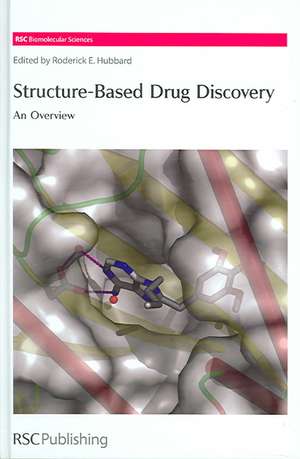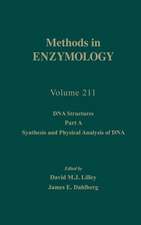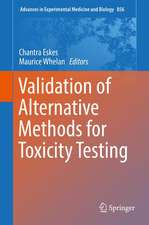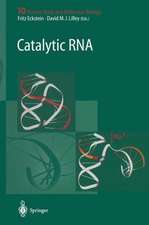Structure-Based Drug Discovery: RSC Biomolecular Sciences
Simon Campbell, Marius Clore, David M.J. Lilley Editat de Roderick E. Hubbarden Limba Engleză Hardback – 6 apr 2006
Din seria RSC Biomolecular Sciences
- 14%
 Preț: 1028.49 lei
Preț: 1028.49 lei - 14%
 Preț: 1127.28 lei
Preț: 1127.28 lei - 14%
 Preț: 1123.82 lei
Preț: 1123.82 lei - 5%
 Preț: 1236.31 lei
Preț: 1236.31 lei - 14%
 Preț: 1129.77 lei
Preț: 1129.77 lei - 14%
 Preț: 1193.61 lei
Preț: 1193.61 lei - 14%
 Preț: 1029.33 lei
Preț: 1029.33 lei - 14%
 Preț: 1193.61 lei
Preț: 1193.61 lei - 27%
 Preț: 2006.97 lei
Preț: 2006.97 lei - 14%
 Preț: 1029.45 lei
Preț: 1029.45 lei - 5%
 Preț: 1143.04 lei
Preț: 1143.04 lei - 14%
 Preț: 1030.44 lei
Preț: 1030.44 lei - 14%
 Preț: 1129.25 lei
Preț: 1129.25 lei - 14%
 Preț: 1127.10 lei
Preț: 1127.10 lei - 14%
 Preț: 1134.26 lei
Preț: 1134.26 lei - 9%
 Preț: 923.14 lei
Preț: 923.14 lei - 9%
 Preț: 923.23 lei
Preț: 923.23 lei - 9%
 Preț: 1006.95 lei
Preț: 1006.95 lei - 9%
 Preț: 922.65 lei
Preț: 922.65 lei - 9%
 Preț: 922.44 lei
Preț: 922.44 lei - 9%
 Preț: 1006.01 lei
Preț: 1006.01 lei
Preț: 1028.80 lei
Preț vechi: 1196.28 lei
-14% Nou
Puncte Express: 1543
Preț estimativ în valută:
196.87€ • 206.23$ • 163.15£
196.87€ • 206.23$ • 163.15£
Carte tipărită la comandă
Livrare economică 09-23 aprilie
Preluare comenzi: 021 569.72.76
Specificații
ISBN-13: 9780854043514
ISBN-10: 0854043519
Pagini: 261
Ilustrații: 1, colour illustrations
Dimensiuni: 161 x 239 x 21 mm
Greutate: 0.58 kg
Editura: RSC Publishing
Seriile RSC Biomolecular Sciences, RSC Biomolecular Sciences (unnumbered)
Locul publicării:United Kingdom
ISBN-10: 0854043519
Pagini: 261
Ilustrații: 1, colour illustrations
Dimensiuni: 161 x 239 x 21 mm
Greutate: 0.58 kg
Editura: RSC Publishing
Seriile RSC Biomolecular Sciences, RSC Biomolecular Sciences (unnumbered)
Locul publicării:United Kingdom
Cuprins
Chapter 1: 3D Structure and the Drug Discovery Process; 1: Introduction; 2: The Drug Discovery Process; 3: What is Structure-based Drug Discovery?; 4: The Evolution of the Ideas of Structure-based Drug Discovery; 5: What isn't in this Book; 6: Concluding Remarks; References; Chapter 2: Structure Detemination - Crystallography for Structure-based Drug Design; 1: What is X-ray Crystallography?; 2: What is required to Produce a Crystal Structure?; 3: Crystallisability of Proteins; 4: How Does the X-ray Data Relate to the Electron Density? The Phase Problem; 5: Electron Density Map Interpretation and Atomic Model of the Protein; 6: Useful Crystallographic Therminology when Utilising Crystal Structures; 7: The Structure Determination Process; 8: Recent technological Advances; 9: The Role of Crystal Structures in the Discovery Process; 10: The Optimal SBDD System; 11: The Impact of Structural Genomics; 12: Producing a Biologically Relevant Structure; 13: Phosphorylation; 14: Balancing Solubility with Crystallisability; 15: Engineering Solubility; 16: Specific Crystal Packing Engineering; 17: Engineering Stability; 18: Use of Surrogate Proteins; References; Chapter 3: Molecular Modelling; 1: Introduction; 2: Methods; 3: Applications; 4: Conclusion; References; Chapter 4: Applications of NMR in Structure-based Drug Design; 1: Introduction; 2: Studying Ligand/Receptor Interactions by NMR; 3: NMR in Structure-based Lead Optimization; 4: Other Applications of NMR in SBDD; 5: Conclusion and Outlook; References; Chapter 5: Fragment Screening - An Introduction; 1: Introduction; 2: The Concept of Drug Likeness; 3: The Evolution of Lead-likeness and Fragment Screening; 4: Finding Fragments by Screening; 5: The Design of Fragment Screening Sets; 6: Turning Fragment Hits into Leads; 7:Summary; References; Chapter 6: Iterative Structure-based Screening of Virtual Chemical Libraries and Factor Xa: Finding the Orally Available Antithrombotic Candadate LY517717; 1: Introduction; 2: Morphology of the Factor Xa Active Site; 3: Structure-based Library Design; 4: Design Strategy for Factor Xa; 5: Introducing Oral Availability; 6: Non-basic S1 Series; 7: Oral Antithrombotic Activity; 8: Conclusion; References; Chapter 7: Anti-influenza Drugs from Sialidase Inhibitors; 1: Introduction; 2: Influenza Viruses; 3: Early Attempts to Discover Neuraminidase Inhibitors; 4: Neuraminidase Structure; 5: Structure-based Discovery of Inhibitors; 6: Retrospective Analyses of Inhibitor-binding; 7: Laboratory Studies of Inhibitor Resistant Variants; 8: Clinical Studies of Drug Resistance; 9: Drug Profiles; Conclusions; References; Chapter 8: Isoform Specificity: The Design of Estrogen Receptor- Selective Compounds; 1: Introduction; 2: Structure-based Design Methodology; 3: The Design of Aryl Diphenolic Azoles as ER? Selective Agonists; 4: Learning From and Moving Beyond the Genistein Scaffold; 5: Evaluation of ER? Selective Compounds in Biological Assays; Conclusions; Acknowledgements; References
Notă biografică
Rod Hubbard has been developing and applying methods to study aspects of protein structure for the past twenty five years. In the 1980s, he developed the molecular modelling and graphics programs QUANTA which is still in use today. From the mid 1980s he helped to build up the Structural Biology Laboratory at York of which he was Director from 1992-2001. During the 1990s, his personal research interests focused on protein-ligand interactions and the structures of therapeutically important proteins such as humanized antibodies, kinases, proteases and nuclear receptors. Since 2001, he has spent part of his time at Vernalis (formerly RiboTargets), establishing structure-based drug discovery. As well as the positions at York and Vernalis, he is also a consultant on structure-based discovery methods to various software, biotechnology and pharmaceutical companies.


























